Laurel Orr
Holistic Evaluation of Language Models
Nov 16, 2022



Abstract:Language models (LMs) are becoming the foundation for almost all major language technologies, but their capabilities, limitations, and risks are not well understood. We present Holistic Evaluation of Language Models (HELM) to improve the transparency of language models. First, we taxonomize the vast space of potential scenarios (i.e. use cases) and metrics (i.e. desiderata) that are of interest for LMs. Then we select a broad subset based on coverage and feasibility, noting what's missing or underrepresented (e.g. question answering for neglected English dialects, metrics for trustworthiness). Second, we adopt a multi-metric approach: We measure 7 metrics (accuracy, calibration, robustness, fairness, bias, toxicity, and efficiency) for each of 16 core scenarios when possible (87.5% of the time). This ensures metrics beyond accuracy don't fall to the wayside, and that trade-offs are clearly exposed. We also perform 7 targeted evaluations, based on 26 targeted scenarios, to analyze specific aspects (e.g. reasoning, disinformation). Third, we conduct a large-scale evaluation of 30 prominent language models (spanning open, limited-access, and closed models) on all 42 scenarios, 21 of which were not previously used in mainstream LM evaluation. Prior to HELM, models on average were evaluated on just 17.9% of the core HELM scenarios, with some prominent models not sharing a single scenario in common. We improve this to 96.0%: now all 30 models have been densely benchmarked on the same core scenarios and metrics under standardized conditions. Our evaluation surfaces 25 top-level findings. For full transparency, we release all raw model prompts and completions publicly for further analysis, as well as a general modular toolkit. We intend for HELM to be a living benchmark for the community, continuously updated with new scenarios, metrics, and models.
Ask Me Anything: A simple strategy for prompting language models
Oct 06, 2022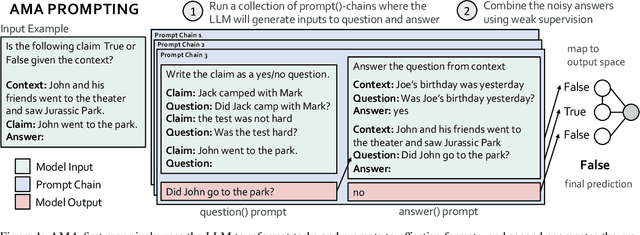
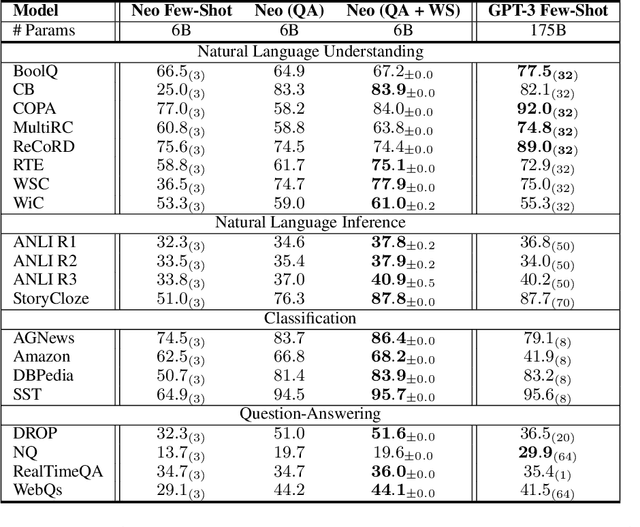


Abstract:Large language models (LLMs) transfer well to new tasks out-of-the-box simply given a natural language prompt that demonstrates how to perform the task and no additional training. Prompting is a brittle process wherein small modifications to the prompt can cause large variations in the model predictions, and therefore significant effort is dedicated towards designing a painstakingly "perfect prompt" for a task. To mitigate the high degree of effort involved in prompt-design, we instead ask whether producing multiple effective, yet imperfect, prompts and aggregating them can lead to a high quality prompting strategy. Our observations motivate our proposed prompting method, ASK ME ANYTHING (AMA). We first develop an understanding of the effective prompt formats, finding that question-answering (QA) prompts, which encourage open-ended generation ("Who went to the park?") tend to outperform those that restrict the model outputs ("John went to the park. Output True or False."). Our approach recursively uses the LLM itself to transform task inputs to the effective QA format. We apply the collected prompts to obtain several noisy votes for the input's true label. We find that the prompts can have very different accuracies and complex dependencies and thus propose to use weak supervision, a procedure for combining the noisy predictions, to produce the final predictions for the inputs. We evaluate AMA across open-source model families (e.g., EleutherAI, BLOOM, OPT, and T0) and model sizes (125M-175B parameters), demonstrating an average performance lift of 10.2% over the few-shot baseline. This simple strategy enables the open-source GPT-J-6B model to match and exceed the performance of few-shot GPT3-175B on 15 of 20 popular benchmarks. Averaged across these tasks, the GPT-Neo-6B model outperforms few-shot GPT3-175B. We release our code here: https://github.com/HazyResearch/ama_prompting
Can Foundation Models Wrangle Your Data?
May 20, 2022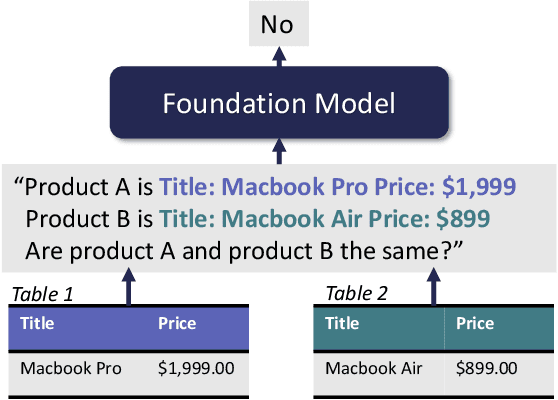
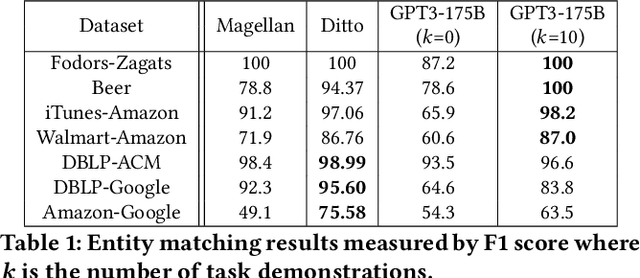
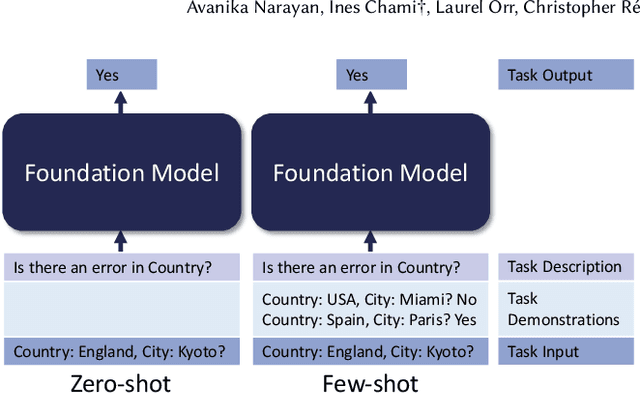
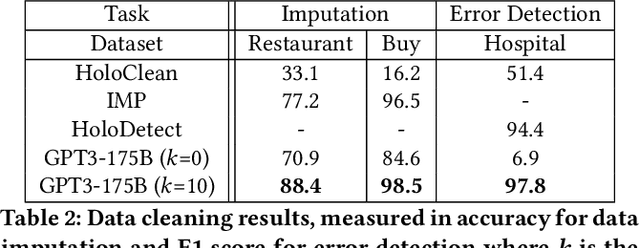
Abstract:Foundation Models (FMs) are models trained on large corpora of data that, at very large scale, can generalize to new tasks without any task-specific finetuning. As these models continue to grow in size, innovations continue to push the boundaries of what these models can do on language and image tasks. This paper aims to understand an underexplored area of FMs: classical data tasks like cleaning and integration. As a proof-of-concept, we cast three data cleaning and integration tasks as prompting tasks and evaluate the performance of FMs on these tasks. We find that large FMs generalize and achieve SoTA performance on data cleaning and integration tasks, even though they are not trained for these data tasks. We identify specific research challenges and opportunities that these models present, including challenges with private and temporal data, and opportunities to make data driven systems more accessible to non-experts. We make our code and experiments publicly available at: https://github.com/HazyResearch/fm_data_tasks.
Cross-Domain Data Integration for Named Entity Disambiguation in Biomedical Text
Oct 15, 2021Abstract:Named entity disambiguation (NED), which involves mapping textual mentions to structured entities, is particularly challenging in the medical domain due to the presence of rare entities. Existing approaches are limited by the presence of coarse-grained structural resources in biomedical knowledge bases as well as the use of training datasets that provide low coverage over uncommon resources. In this work, we address these issues by proposing a cross-domain data integration method that transfers structural knowledge from a general text knowledge base to the medical domain. We utilize our integration scheme to augment structural resources and generate a large biomedical NED dataset for pretraining. Our pretrained model with injected structural knowledge achieves state-of-the-art performance on two benchmark medical NED datasets: MedMentions and BC5CDR. Furthermore, we improve disambiguation of rare entities by up to 57 accuracy points.
On the Opportunities and Risks of Foundation Models
Aug 18, 2021
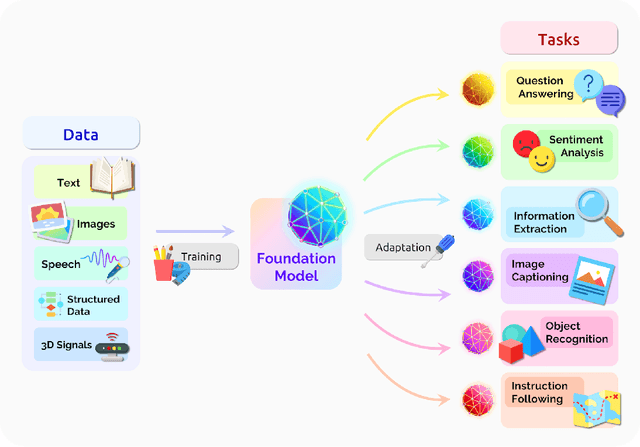
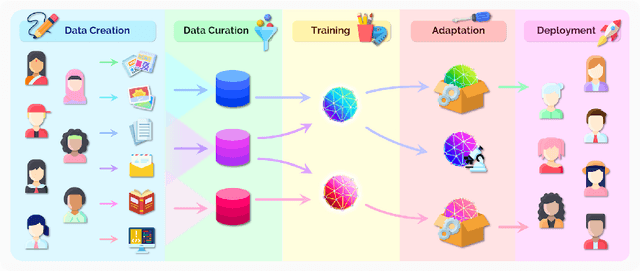
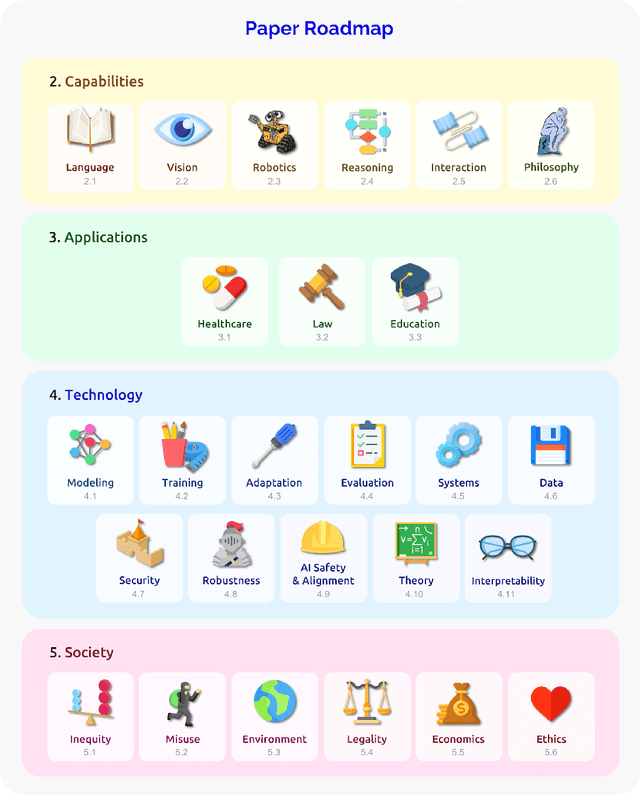
Abstract:AI is undergoing a paradigm shift with the rise of models (e.g., BERT, DALL-E, GPT-3) that are trained on broad data at scale and are adaptable to a wide range of downstream tasks. We call these models foundation models to underscore their critically central yet incomplete character. This report provides a thorough account of the opportunities and risks of foundation models, ranging from their capabilities (e.g., language, vision, robotics, reasoning, human interaction) and technical principles(e.g., model architectures, training procedures, data, systems, security, evaluation, theory) to their applications (e.g., law, healthcare, education) and societal impact (e.g., inequity, misuse, economic and environmental impact, legal and ethical considerations). Though foundation models are based on standard deep learning and transfer learning, their scale results in new emergent capabilities,and their effectiveness across so many tasks incentivizes homogenization. Homogenization provides powerful leverage but demands caution, as the defects of the foundation model are inherited by all the adapted models downstream. Despite the impending widespread deployment of foundation models, we currently lack a clear understanding of how they work, when they fail, and what they are even capable of due to their emergent properties. To tackle these questions, we believe much of the critical research on foundation models will require deep interdisciplinary collaboration commensurate with their fundamentally sociotechnical nature.
Managing ML Pipelines: Feature Stores and the Coming Wave of Embedding Ecosystems
Aug 11, 2021
Abstract:The industrial machine learning pipeline requires iterating on model features, training and deploying models, and monitoring deployed models at scale. Feature stores were developed to manage and standardize the engineer's workflow in this end-to-end pipeline, focusing on traditional tabular feature data. In recent years, however, model development has shifted towards using self-supervised pretrained embeddings as model features. Managing these embeddings and the downstream systems that use them introduces new challenges with respect to managing embedding training data, measuring embedding quality, and monitoring downstream models that use embeddings. These challenges are largely unaddressed in standard feature stores. Our goal in this tutorial is to introduce the feature store system and discuss the challenges and current solutions to managing these new embedding-centric pipelines.
Bootleg: Chasing the Tail with Self-Supervised Named Entity Disambiguation
Oct 23, 2020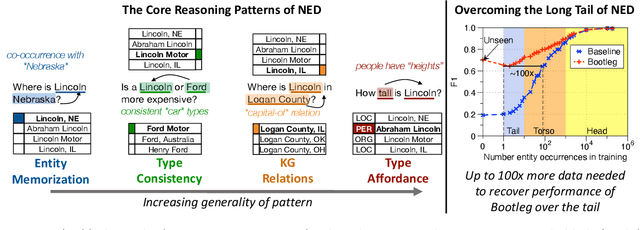
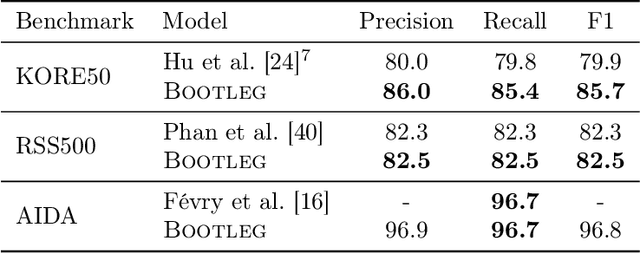
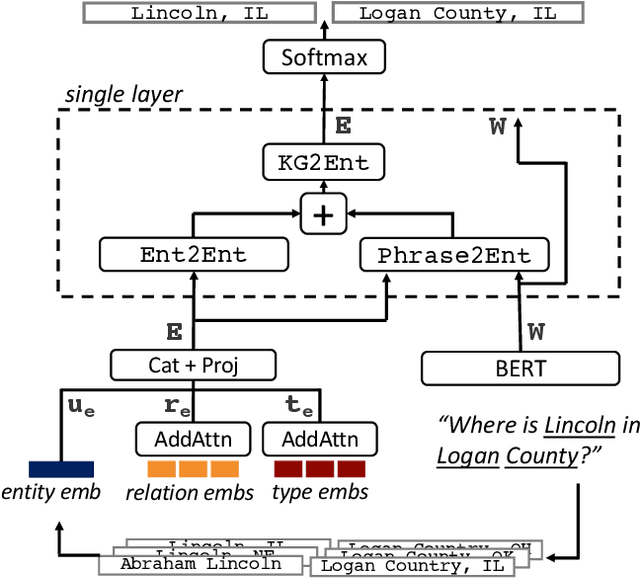

Abstract:A challenge for named entity disambiguation (NED), the task of mapping textual mentions to entities in a knowledge base, is how to disambiguate entities that appear rarely in the training data, termed tail entities. Humans use subtle reasoning patterns based on knowledge of entity facts, relations, and types to disambiguate unfamiliar entities. Inspired by these patterns, we introduce Bootleg, a self-supervised NED system that is explicitly grounded in reasoning patterns for disambiguation. We define core reasoning patterns for disambiguation, create a learning procedure to encourage the self-supervised model to learn the patterns, and show how to use weak supervision to enhance the signals in the training data. Encoding the reasoning patterns in a simple Transformer architecture, Bootleg meets or exceeds state-of-the-art on three NED benchmarks. We further show that the learned representations from Bootleg successfully transfer to other non-disambiguation tasks that require entity-based knowledge: we set a new state-of-the-art in the popular TACRED relation extraction task by 1.0 F1 points and demonstrate up to 8% performance lift in highly optimized production search and assistant tasks at a major technology company
Mosaic: A Sample-Based Database System for Open World Query Processing
Jan 10, 2020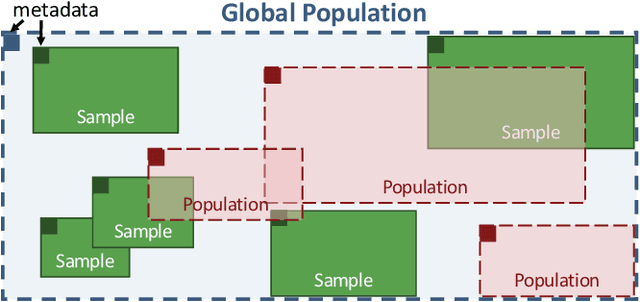

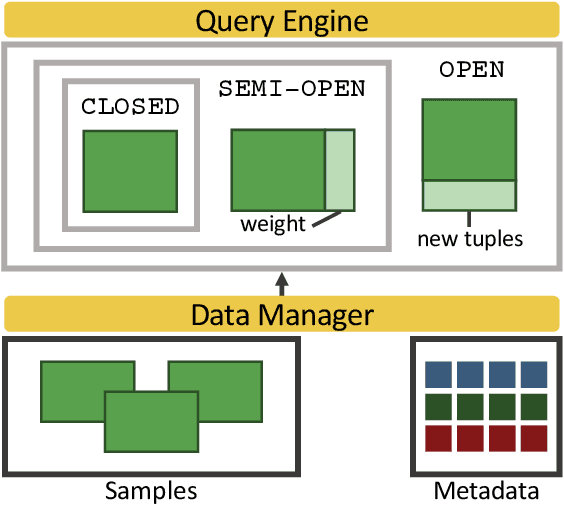
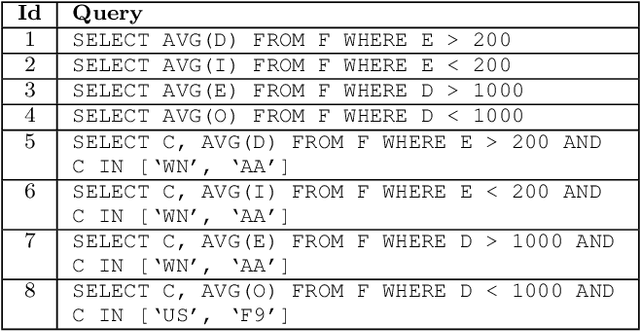
Abstract:Data scientists have relied on samples to analyze populations of interest for decades. Recently, with the increase in the number of public data repositories, sample data has become easier to access. It has not, however, become easier to analyze. This sample data is arbitrarily biased with an unknown sampling probability, meaning data scientists must manually debias the sample with custom techniques to avoid inaccurate results. In this vision paper, we propose Mosaic, a database system that treats samples as first-class citizens and allows users to ask questions over populations represented by these samples. Answering queries over biased samples is non-trivial as there is no existing, standard technique to answer population queries when the sampling probability is unknown. In this paper, we show how our envisioned system solves this problem by having a unique sample-based data model with extensions to the SQL language. We propose how to perform population query answering using biased samples and give preliminary results for one of our novel query answering techniques.
 Add to Chrome
Add to Chrome Add to Firefox
Add to Firefox Add to Edge
Add to Edge